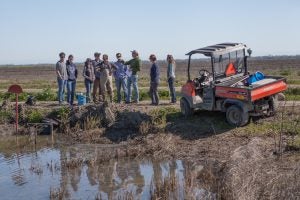Stewardship of our land and water resources has always played a central role in my life.
I grew up “out in the country,” as we call it, on a-five acre “farm” in Yolo County, California – large enough for raising pigs and sheep, which my older brothers and I would show at the annual 4-H Fair in nearby Woodland.
Living in the Central Valley, we could always count on very hot, dry summers and occasional consecutive dry years, which inevitably were followed by years of heavy rains and even flooding. From a very young age, I understood how important it was to be smart about how we managed our water supply and the surrounding landscape for people, wildlife and the environment.
I recall my parents expressing concerns over lowering groundwater levels, which our community depended on for drinking water and which supported local streams and wildlife. These concerns would soon be replaced with fears of severe flooding and property damage – an unfortunate reality of living in an area that was once a functioning floodplain.
In all, I had a front row seat to California’s extremely variable climate, hydrology and subsequent ripple effect of impacts.
Embracing different perspectives

Author Ann Hayden stresses the importance of conservation management
I learned early in my career that there are no single, silver-bullet solutions to complex environmental issues. In fact, approaches that consider an array of perspectives and disciplines are often the most effective way to address difficult resource challenges.
From my time in the Peace Corps, where I developed protected-area management plans in coastal Belize, to graduate school at University of California, Santa Barbara, where I focused on environmental science and water resource management, I was regularly reminded of the importance of a multi-disciplinary approach to conservation. I learned how important it is to look at problems through the eyes of others, even if their background and values appear different from my own. At the core of this approach is the importance of fostering relationships with people, something I’ve come to value most about my job at Environmental Defense Fund (EDF).
When I first joined EDF, I had the prodigious opportunity to work with the late Tom Graff, a legend in California water law and policy. Tom established EDF’s California office in the early 1970s and was instrumental in developing EDF’s water program. In many ways, he epitomized the philosophy of considering different points of view and reaching across the aisle to engage in healthy debates with adversaries and allies alike.
Now, nearly 15 years into my career at EDF, I often think back to our time together for inspiration as I continue to cultivate meaningful partnerships and pursue solutions to many of the initiatives that Tom set in motion.
[Tweet “Incentive-based management can build a balanced and resilient water system, via @GrowingReturns.https://edf.org/7vu”]
A water market for the future
After years working to improve water resource management in California, I am encouraged by progress being made in the state and throughout the West.
The passage of the historic Sustainable Groundwater Management Act in 2014, in particular, is allowing for a real discussion about what a balanced and resilient water system means to stakeholders across the state.
For EDF, we see this as an opportunity to advance smart, incentive-based management approaches, such as groundwater trading, to help farmers transition to a future with less groundwater while taking into account the needs of disadvantaged communities and ecosystems.
Incentivizing better resource management

Hayden family manages their water resource
While conservation of freshwater resources has been core to my work at EDF, I also work to promote EDF’s wildlife conservation goals and advance the inherent synergies between the two initiatives.
I lead EDF’s work on the Central Valley Habitat Exchange, which EDF and its partners developed to incentivize farmers and ranchers to restore important habitat on their land while maintaining, or even increasing, agricultural productivity.
Through this program, landowners are paid to conserve their land in ways that protect floodplains and enhance wildlife and riparian habitats. Countless farmers have demonstrated that they can – and want – to both “grow habitat” and grow crops, and it is our job to make sure they are appropriately compensated so this becomes common practice across the state. We are also looking into ways to compensate landowners for additional benefits their practices might accrue, such as recharging valuable groundwater aquifers.
From passion to responsibility
Over time, my childhood interest in protecting the environment has evolved into a deep sense of responsibility to protect it. As a mother of two young boys who often visit their grandparents “out in the country,” I feel even greater urgency to achieve the ambitious goals we have set for managing our water and habitat resources.
Forging partnerships with a wide array of organizations, communities and individuals gives me confidence that the work we’re doing at EDF is laying the path for resilient natural resources today and into the future.
Related:
These reforms can unclog California’s water market and help the environment >>
From Tennessee to the arid West, water runs through my work >>
From Mexico City to San Francisco: A multi-national perspective on water management >>










One Comment
Annie,
Loved your article….so well-written, so heart-felt.
Xoxo , Carol